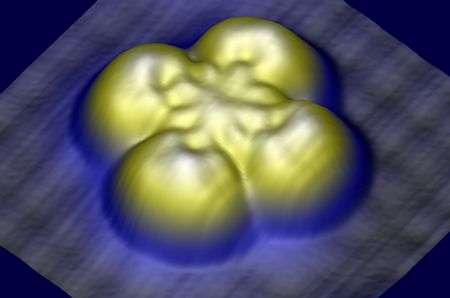Using a single molecule to create a new magnetic field sensor

Researchers at the University of Liverpool and University College London (UCL) have shown a new way to use a single molecule as a magnetic field sensor.
In a study, published in Nature Nanotechnology, the team shows how magnetism can manipulate the way electricity flows through a single molecule, a key step that could enable the development of magnetic field sensors for hard drives that are a tiny fraction of their present size.
In hard drives, magnetised areas on spinning disks are used to store information. As the magnetised areas pass a magnetic sensor, they trigger fluctuations in electric current flowing through the sensor, allowing the data to be read. Making these areas smaller increases a hard drive's storage capacity without making it bigger, but also requires a smaller sensor.
Fadi El Hallak, a researcher at UCL who conceived of the study and now works for Seagate Technology, said: "Making smaller sensors isn't trivial. It is difficult to use magnetism to control the current flowing through objects the size of single molecules because the response to changes in the magnetic field is often very weak".
To get around this problem, the researchers developed a method of magnifying the effect of the magnetism on the flow of current in the detector.
Mechanical Tunnelling
First, they created a junction in which a single magnetic molecule was weakly coupled to two metallic leads. The barriers between the molecule and the nearby metals were high enough that electrical charge in the metals could not flow over the barriers.
However, a small fraction of the electrons can effectively go through the barriers by undergoing quantum mechanical tunnelling, which enables a tiny current to flow through the molecule when a voltage is applied across it.
The scientists configured the junction so that the molecule was much more strongly connected to one metal lead than the other. The effect of the magnetic field on the tunnelling current is then leveraged and greatly enhanced.
Dr Mats Persson, from the University of Liverpool's Department of Chemistry, said: "This research demonstrates a new kind of single molecule sensor for magnetic fields, which is promising for creating new computer technologies."
More information: "Tunable magnetoresistance in an asymmetrically coupled single-molecule junction." Nature Nanotechnology (2015) DOI: 10.1038/nnano.2014.326
Journal information: Nature Nanotechnology
Provided by University of Liverpool



















